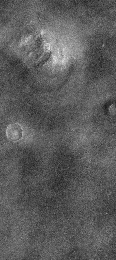The Mars Global Surveyor team's first image of the Cydonia region of Mars (the area containing the "Face on Mars").
Click on image for full size
Courtesy of NASA
Face-Off!
News story originally written on April 8, 1998
The camera aboard the
Mars Global Surveyor (MGS) has imaged an area of the Cydonia Region of Mars. It was here that the 'Face on Mars' was
first photographed by the 1976 Viking mission.
In the 20 years since the 'Face' was photographed, most scientists have held to the view that the image of the 'Face' was just a trick of light and shadow upon natural geological features. However, there were many believers of extraterrestial life who thought the image was showing what could have been part of an ancient city on Mars...shaped like a face to attract exploration of that area.
The range of the MGS image was taken at 444.21 kilometers whereas the Viking image was taken at a range of 1873 kilometers. That means that the more recent MGS image is more accurate. As one can see from the new MGS photo on the left, the 'Face' is more likely just a geological feature. "It's a butte, a mesa, a knob," said Michael Ravine, advanced projects manager at Malin Space Science Systems in San Diego, which operates Surveyor's camera. "Nothing jumps out at me and screams, 'This must have been built by the forces of intelligence'."
Because of the controversy involved about the 'Face on Mars', NASA has offered no opinion. Though it seems this two-decade face-off is coming to a close as the MGS has provided images of only geological features...
You might also be interested in:

It was another exciting and frustrating year for the space science program. It seemed that every step forward led to one backwards. Either way, NASA led the way to a great century of discovery. Unfortunately,
...more
The Space Shuttle Discovery lifted off from Kennedy Space Center at 2:19 p.m. EST, October 29th. The sky was clear and the weather was great as Discovery took 8 1/2 minutes to reach orbit for the Unitied
...more
A moon was discovered orbiting the asteroid, Eugenia. This is only the second time in history that a satellite has been seen circling an asteroid. A special mirror allowed scientists to find the moon
...more
Will Russia ever put the service module for the International Space Station in space? NASA officials are demanding an answer from the Russian government. The necessary service module is currently waiting
...more
During a period of about two days in early May, 1998, the ACE spacecraft was immersed in plasma associated with a coronal mass ejection (CME). The SWICS instrument on ACE, which determines unambiguously
...more
J.S. Maini of the Canadian Forest Service has referred to forests as the "heart and lungs of the world." Forests reduce soil erosion, maintain water quality, contribute to atmospheric humidity and cloud
...more
In late April through mid-May 2002, all five naked-eye planets are visible simultaneously in the night sky! This is includes Mercury which is generally very hard to see because of its proximity to the
...more















